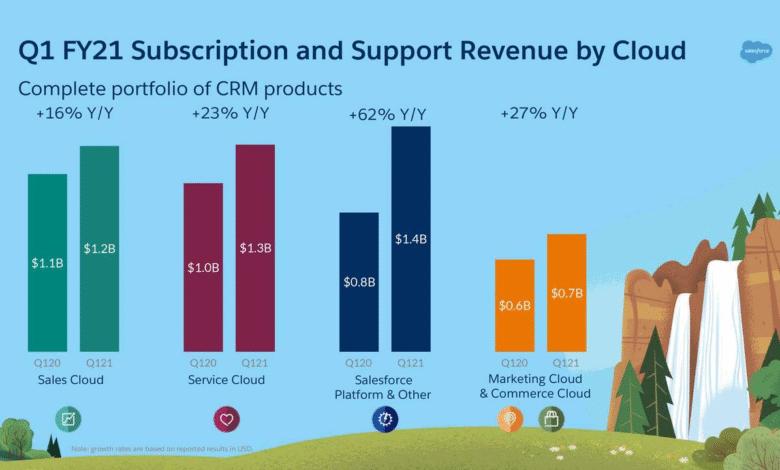Salesforce Q1 Earnings Report 2026: Key Highlights

The Salesforce Q1 Earnings Report 2026 has generated significant attention in the financial world, as the renowned sales and customer service software company showcases robust fiscal results. In a landscape marked by economic uncertainty, Salesforce reported an impressive revenue growth of 8% year over year, signaling a resilient performance amid broader market challenges. The company’s adjusted earnings per share came in at $2.58, slightly above the expected $2.54, further bolstering confidence in Salesforce stock performance. With total revenue hitting $9.83 billion, exceeding forecasts, the earnings report paints an optimistic picture for investors looking to understand the future trajectory of Salesforce. As the tech giant navigates acquisitions and strategic adjustments, stakeholder interest remains high, especially with its plans to expand through ventures like the Informatica deal.
In its latest fiscal update, Salesforce has demonstrated solid performance metrics amid a complex economic backdrop. This quarterly earnings disclosure illustrates the company’s strategic foresight, particularly in revenue increases and adjusted earnings projections that outstripped analyst expectations. As it continues to evolve its market position by enhancing its portfolio, Salesforce has become a focal point for discussions surrounding technology investments and growth opportunities. This earnings report not only highlights the financial health of Salesforce but also reflects broader themes in the tech industry, where innovative solutions and strategic acquisitions play critical roles in sustaining momentum. Investors and analysts alike are keenly observing Salesforce’s trajectory as it charts its course through this competitive landscape.
Salesforce Q1 Earnings Report 2026 Overview
Salesforce, a leader in sales and customer service software solutions, witnessed a positive response in its stock performance following its Q1 earnings report for 2026. Shares surged by 4% in extended trading, reflecting investor confidence after the company exceeded expectations in both earnings per share and revenue figures. Adjusted earnings per share of $2.58 surpassed the anticipated $2.54, contributing to a robust net income of $1.54 billion. This performance underscores Salesforce’s ongoing commitment to delivering value to its shareholders, even amidst challenging market conditions.
In the fiscal first quarter, Salesforce recorded an impressive revenue of $9.83 billion, marginally exceeding analyst forecasts of $9.75 billion. This achievement translates to an 8% growth year-over-year, highlighting the company’s ability to sustain revenue growth despite economic uncertainty. Co-founder and CEO Marc Benioff’s strategic decisions, including the acquisition of Informatica for $8 billion, positioned Salesforce for future expansion and market presence, which analysts suggest may mitigate investor concerns regarding spending and growth.
Analysis of Salesforce’s Revenue Growth Strategy
Salesforce’s impressive revenue growth in Q1 2026 can be attributed to several strategic initiatives that focus on innovation and expansion. The introduction of the AgentExchange marketplace for artificial intelligence agents illustrates Salesforce’s commitment to harnessing technology to enhance customer experience and engagement. Such innovations are expected to drive additional revenue streams, propelling the company to maintain its competitive edge in a rapidly evolving market where technological advancements play a crucial role.
Furthermore, the proactive approach of reducing workforce numbers by 10% demonstrates Salesforce’s responsiveness to market dynamics and investor concerns. This strategic move is aimed at optimizing operational efficiency while ensuring that the company can continue to invest in key areas that drive revenue growth, such as artificial intelligence and cloud services. Maintaining investor confidence through calculated spending cuts and targeted acquisitions such as Informatica will be vital for sustaining long-term revenue growth.
Salesforce Earnings Per Share and Future Projections
Investors closely monitor Salesforce’s earnings per share (EPS) as a key performance indicator, and the Q1 results for 2026 show an optimistic outlook. The company projected adjusted EPS between $2.76 and $2.78 for the fiscal second quarter, indicating a consistent upward trajectory in profits. Analysts’ expectations showed slight adjustments with projections estimating lower earnings, reflective of ongoing economic challenges, yet Salesforce’s cautious optimism sets a positive tone for upcoming quarters.
Moreover, Salesforce has raised its full-year guidance for both adjusted EPS and revenue, expecting earnings between $11.27 to $11.33 and revenue of $41.0 billion to $41.3 billion. This revision indicates a strong confidence in the company’s performance and the effectiveness of its strategic initiatives despite past fluctuations in stock performance, including an 18% decrease in 2025. Delivering on these earnings projections will be essential for bolstering investor trust and positioning Salesforce as a resilient player in the software industry.
The Impact of Mergers and Acquisitions on Salesforce
Salesforce’s recent $8 billion acquisition of Informatica is a significant move aimed at amplifying its market footprint and technological capabilities. This acquisition is notable as Salesforce seeks to enhance its data management offerings while reducing operational redundancies that may hinder growth. Analysts have responded positively, viewing this deal as more digestible than larger predecessors such as the acquisition of Slack for $27.1 billion, suggesting that investors may welcome this strategy as a means for sustainable growth.
However, the challenge lies in effectively integrating Informatica’s operations within Salesforce to realize the anticipated synergies. As the company navigates through this merger, it’s vital to maintain focus on optimizing costs and enhancing revenue streams. The disbandment of the board’s mergers and acquisitions committee signifies a shift in how Salesforce approaches future growth strategies, marking an operational overhaul designed to improve both margins and operational resilience.
Salesforce Stock Performance Amidst Economic Challenges
Despite a commendable performance in Q1 2026, Salesforce has faced stock performance challenges leading into 2025, with shares decreasing approximately 18%. This decline contrasts with robust revenue and earnings results, raising questions about market sentiment and investor confidence in the company’s long-term growth narrative. The broader economic climate, coupled with the implications of proposed tariffs on imports, adds another layer of complexity to Salesforce’s stock performance as it navigates future uncertainties.
Investors will be closely monitoring how effectively Salesforce can stabilize its stock performance while executing on growth plans and maintaining operational efficiencies. The upcoming analysts’ conference call will provide further insights into the strategic direction and financial health of the company. Investors should remain alert not only to earnings and growth forecasts but also to the tactical measures taken by Salesforce to regain momentum in stock performance amidst an unpredictable economic landscape.
Salesforce’s Financial Guidance and Market Expectations
Following the release of the Q1 earnings report, Salesforce raised its financial guidance, reflecting confidence in its operational strategy and market positioning. Analysts’ consensus estimates aligned closely with Salesforce’s projections, endorsing the outlook for continued revenue and earnings growth. This level of alignment indicates that market expectations were set realistically, enabling Salesforce to potentially exceed those projections in subsequent quarters, provided that the company adheres to its strategic initiatives and maintains effective cost management.
In a highly competitive technology landscape, Salesforce’s ability to project adjusted earnings per share in the range of $11.27 to $11.33 for the fiscal year will be closely scrutinized by stakeholders. Robust financial guidance serves as a critical driver for investor sentiment, especially following periods of stock volatility. As the market evolves, Salesforce must effectively communicate its growth strategies and performance to bolster confidence and promote a stable investment environment.
Salesforce’s Innovations Driving Future Growth
Salesforce’s dedication to innovation is exemplified by its recent launches, particularly the AgentExchange marketplace designed for artificial intelligence agents. This initiative not only positions Salesforce at the forefront of technological advancement but also aims to attract a broader customer base seeking cutting-edge solutions. By aligning its service offerings with emerging technology trends, Salesforce is well-prepared to capitalize on future growth opportunities across diverse market segments.
Additionally, the focus on data management through the Informatica acquisition bolsters Salesforce’s capabilities in analytics and customer insights. Such enhancements provide organizations with critical tools to improve decision-making and operational efficiency. As companies increasingly prioritize data-driven strategies, Salesforce’s commitment to innovation will be essential for maintaining competitive momentum and fostering long-term relationships with clientele.
Challenges and Opportunities in Salesforce’s Fiscal Landscape
While Salesforce showcased positive earnings and revenue growth in Q1 2026, it must also address underlying challenges that come with such performance. Activist investors have raised concerns about increased spending in the face of slower revenue growth, prompting management to make deliberate adjustments, such as workforce reduction. The balance between investing in growth and managing operational costs will be crucial as Salesforce navigates its fiscal landscape moving forward.
However, the challenges faced could also present unique opportunities for Salesforce to revisit its operational strategies and streamline efficiencies. Identifying and implementing cost-effective measures will be essential to ensure continued growth while satisfying investor appetite for profitability. As Salesforce moves ahead with its plans, it is poised not only to address current challenges but also to seize opportunities that solidify its position as a leader in the software industry.
Looking Ahead: Salesforce’s Strategic Vision
Salesforce’s strategic vision for the future hinges on its ability to leverage technological advancements and market opportunities to sustain its growth trajectory. The continued push for innovative solutions, such as artificial intelligence and data management, signifies a commitment to staying ahead of industry trends. By aligning its resources towards these forward-thinking initiatives, Salesforce aims to solidify its leadership position in the SaaS market.
Moreover, transparent communication with investors about the company’s strategic direction will be critical in nurturing long-term relationships. As Salesforce prepares for further discussions with analysts and stakeholders, presenting a clear narrative about its growth strategy, tailored projects, and expectations for future performance will be essential in fostering investor confidence and ensuring market stability.
Frequently Asked Questions
What were the key highlights from the Salesforce Q1 Earnings Report 2026?
The Salesforce Q1 Earnings Report 2026 highlighted earnings per share of $2.58, exceeding the expected $2.54, and revenue of $9.83 billion, surpassing the estimated $9.75 billion. Revenue grew by 8% year over year, with a net income of $1.54 billion.
How did Salesforce’s revenue growth compare to expectations in the Q1 Earnings Report 2026?
In the Salesforce Q1 Earnings Report 2026, the company achieved revenue growth of 8% year over year, which was better than the expected figures. The reported revenue of $9.83 billion compared favorably to the LSEG consensus of $9.75 billion.
What is the outlook for Salesforce’s fiscal results based on the Q1 Earnings Report 2026?
Based on the Salesforce Q1 Earnings Report 2026, the company raised its full-year forecast, projecting adjusted earnings per share between $11.27 and $11.33 and revenue of $41.0 billion to $41.3 billion, which is above previous expectations.
How did Salesforce stock perform following the Q1 Earnings Report 2026?
Following the Salesforce Q1 Earnings Report 2026, the stock rose by 4% in extended trading. Despite a decrease of about 18% throughout 2025, this positive reaction indicates investor confidence post-report.
What were the adjustments made by Salesforce in response to investor concerns in the Q1 Earnings Report 2026?
In response to concerns regarding increased spending amid slowing revenue growth highlighted in the Salesforce Q1 Earnings Report 2026, the company announced a workforce reduction of 10% and disbanded its mergers and acquisitions committee.
What acquisition did Salesforce announce in the Q1 Earnings Report 2026?
In the Salesforce Q1 Earnings Report 2026, the company announced its plan to acquire Informatica for $8 billion, marking a significant addition to its portfolio and reflecting a strategic move in data management.
What future earnings predictions did Salesforce provide in its Q1 Earnings Report 2026?
For the fiscal second quarter, Salesforce projected adjusted earnings per share between $2.76 and $2.78 with revenue estimates between $10.11 billion and $10.16 billion, indicating continued growth following the Q1 Earnings Report 2026.
How did Salesforce’s management respond to the performance reported in the Q1 Earnings Report 2026?
Salesforce management, including CEO Marc Benioff, expressed optimism about the Q1 performance and future prospects, citing strategic acquisitions and operational adjustments as key factors for maintaining growth.
What implications do the results of the Salesforce Q1 Earnings Report 2026 have for investors?
The results from the Salesforce Q1 Earnings Report 2026 suggest a positive outlook for investors, with a raised full-year forecast and a strategic acquisition, which may enhance long-term growth and stability in the company’s stock performance.
How did analysts react to Salesforce’s Q1 Earnings Report 2026?
Analysts reacted positively to the Salesforce Q1 Earnings Report 2026, maintaining a buy rating on the company’s stock, particularly in light of the Informatica acquisition and strong earnings performance compared to expectations.
| Key Metrics | Salesforce Q1 Earnings Report 2026 | Expected | |
|---|---|---|---|
| Earnings per Share (Adjusted) | $2.58 | $2.54 | |
| Revenue | $9.83 billion | $9.75 billion | |
| Year-over-Year Revenue Growth | 8% | N/A | |
| Net Income | $1.54 billion ($1.59 per share) | N/A | |
Summary
The Salesforce Q1 Earnings Report 2026 highlights the company’s strong performance with adjusted earnings per share of $2.58, surpassing expectations, and revenues of $9.83 billion. Despite concerns from activist investors about spending and growth, Salesforce’s optimism is reflected in its acquisition of Informatica, marking a strategic move in the data management space. The company has increased its full-year revenue forecast and announced measures such as workforce reductions and dividend payments to enhance shareholder value. As Salesforce continues to innovate and expand, its proactive steps suggest a commitment to long-term growth despite market fluctuations.




